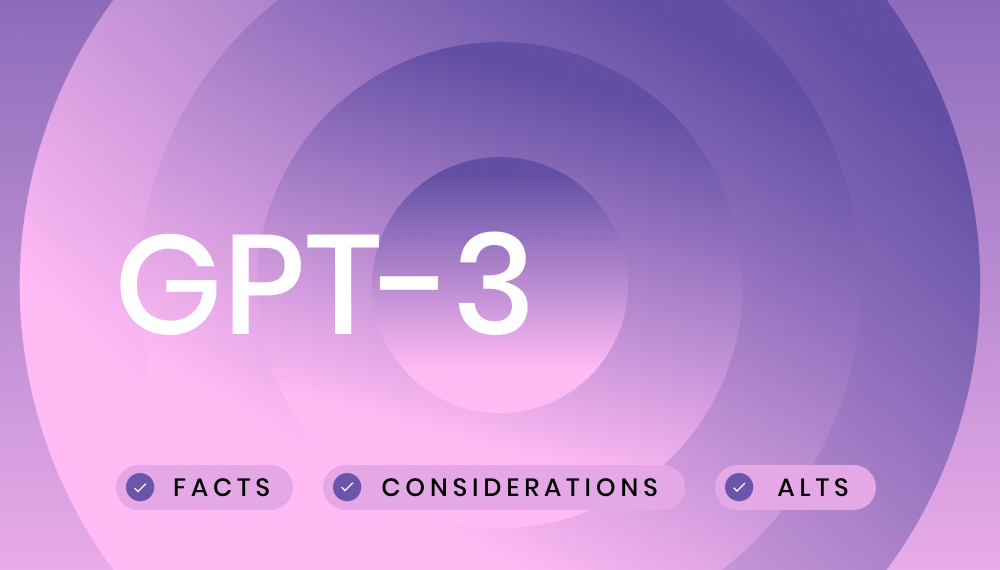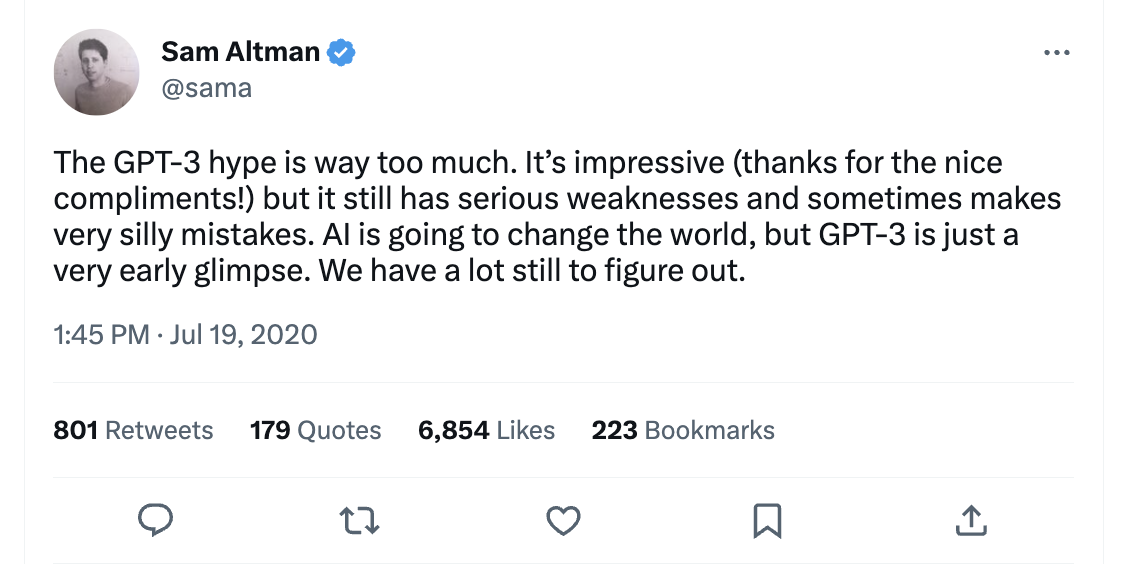AI in action
– 12 min read
What’s GPT-3?
Facts, considerations, and alternatives for enterprise use

By the time this article is published, it’ll already be outdated. That’s how fast the pace of innovation is for generative AI. It was only a few months ago that OpenAI’s large language model (LLM) GPT-3, was publicized as one of the major technological breakthroughs of the 21st century — and it’s already considered obsolete when compared to other LLMs.
But if you’re new to the world of AI, having a clear understanding of GPT-3 will help give you context on later generations, the business risks associated with using tools powered by GPT-3, and the landscape of generative AI technology beyond GPT-3 and ChatGPT.
By the end of this article, you’ll have a better understanding of what GPT-3 is, what considerations you should keep in mind for business use, and how enterprise-ready alternatives like Palmyra help companies become content powerhouses with generative AI.
- GPT-3 is a deep learning autoregressive language model that can generate human-like text when given a prompt
- Businesses are using GPT-3 for a variety of tasks, such as content creation, copywriting, predictive abilities, and programming
- Risks associated with GPT-3 include false and biased output, lack of critical thinking and creativity, insufficient understanding of context, lack of knowledge about the brand, and data and security concerns
- Alternatives to GPT-3 include GPT-4 and Palmyra, which offers its own proprietary LLMs with integrated writing experiences, third-party application support, and claim detection to protect the brand’s reputation
- For companies looking to use generative AI, they should consider solutions with specific use cases and ensure they are aware of potential risks and pitfalls.
What is GPT-3?
GPT-3 (Generative Pre-trained Transformer 3) is a deep learning autoregressive language model. That’s a mouthful of tech-speak for “a machine learning model that predicts the next word based on past context and words.”
Simply put, GPT-3 can generate text that sounds natural and human-like. When a user inputs a prompt or request, the model uses the power of artificial intelligence to generate a response that’s the most accurate and fluent.
This is possible because GPT-3 uses a language learning model trained on 175bn parameters. In other words, GPT-3 is trained on over eight years worth of data collected from a variety of sources, including the English version of Wikipedia, and a repository of web crawl data called Common Crawl. GPT-3 is trained on data collected up to 2021. So don’t even try to ask it about the series finale to The Walking Dead, unless you want a made up answer (a problem we’ll discuss later in this article).

This vast amount of training data allows GPT-3 to detect data patterns and generate sentences that are convincingly human, and mostly accurate. A version of GPT-3, GPT-3.5, is the model that powers OpenAI’s chatbot, ChatGPT.
How are businesses using GPT-3 today?
As a commercially available API, GPT-3 allows developers to build their products on the GPT-3 framework for a licensing fee.
Developers are using GPT-3 to build tools that’ll help people save time, improve their content creation, and harness internet information to optimize task roles.
Companies are using GPT-3 powered tools for myriad reasons. Here are a few:
- Content creation: from blogs to ebooks to social media, GPT-3 can curate text in seconds
- Copywriting: website content and product descriptions
- Predictive ability: search and data analysis
- Programming and coding: finding and fixing bugs in code, or translating between programming language
In short, businesses are relying on GPT-3’s capabilities to increase efficiency in all their operations and optimize processes that’d otherwise require significant manual effort and resources.
What are the risks associated with GPT-3?
In the words of OpenAI founder, Sam Altman, GPT-3 “has serious weaknesses and sometimes makes very silly mistakes… AI is going to change the world, but GPT-3 is just a very early glimpse.”

Generative AI has become the “new thing.” It’s the recurring conversation held in every company’s coffee corner and every LinkedIn feed.
What once was cutting-edge technology for the tech-savvy few has piqued interest from even the most mainstream enterprise companies looking to understand generative AI and explore use cases for adoption.
But any enterprise looking for AI generative solutions needs to be aware of the risks and gaps that exist in current solutions.
False and biased GPT-3 output could tarnish a brand’s reputation
Your company’s digital presence relies on its reputation and authority on industry topics. Relying too heavily on GPT-3 could put your brand’s reputation on the line as it can’t fact-check and accurately represent information.
It all comes down to “garbage in, garbage out.” The vast datasets GPT-3 is trained on contain pretty much everything published on the internet up until 2021, including misinformation, outdated material, and content containing biases regarding race, gender, and other demographic factors. As a result, outputs from GPT-3 powered tools have the potential to spew inaccurate, harmful content that perpetuates discrimination.
There have been many cases where GPT-3 has been accused of showing a bias in its responses.
For example, a researcher at the University of California, Berkeley’s Computation and Language Lab reported that ChatGPT (powered by GPT-3.5) proposed that people deserve to be tortured if they were from North Korea, Syria, or Iran.
A study by the University of Santa Clara that found GPT-3 had a “brilliance” bias against women.
As GPT-3 is a “black box”, there’s no real way to quality-check training data inputs. It means any content generated by GPT-3 could be inaccurate and misrepresented. When this content is linked to a brand, it can negatively affect the brand’s reputation, which can be extremely damaging.
GPT-3 lacks critical thinking and creativity for thought leadership
Since GPT-3 is based on algorithms, it simply mimics patterns. It lacks the ability to provide fresh insights informed by experience or creativity. It relies on the quality of your inputs and cannot apply original ideas to new contexts.
As such, if a company relies on GPT-3 to advocate for their thoughts and opinions, it risks finding roadblocks or inaccurate content.
This could be problematic when it comes to marketing or other creative endeavors, as content created with GPT-3 may lack the necessary human touch or creative flair.
GPT-3 has an insufficient understanding of context
GPT-3 is also limited in its ability to understand the context of a given situation. It relies heavily on data and input from the user, which, if incorrect or missing, can lead to inaccurate results.
For example, GPT-3 may be unable to distinguish between a humorous comment and a serious one, or may fail to grasp the subtleties of a complex situation.
It’s essential to monitor the quality of the content produced and be aware of the potential for tarnishing a brand’s reputation, lack of creativity, and insufficient understanding of context.
GPT-3 doesn’t know your brand
Content that represents your brand is instrumental for the success of a company’s online presence and recognition.
Ultimately, GPT-3 isn’t an employee at your company who has been trained to understand your company’s values and product offerings. The lack of training means GPT-3 doesn’t understand how to echo your brand’s mission in its content, and it can create bottlenecks to creative efforts.
As the output of GPT-3 is based on a generic algorithm, it’s not aligned with your brand. As a result, GPT-3 limits your brand’s strength and growth.
Using GPT-3 for cross-departmental collaboration is complicated
Cross-department collaboration can become a challenge quickly, as departments have different ideas on how best to use GPT-3 or how much autonomy it should have when making decisions.
And due to the nature of GPT-3 requiring single prompts, scaling content across an organization is tricky. As each new content starts from scratch with a different prompt. This means there’s no straightforward way to repeat common use cases for each team’s needs.
For companies looking to use generative AI, they need to be on the hunt for solutions that have specific use cases for their teams. As this will empower teams with tools to support their content goals as a whole, and not as single prompts.
GPT-3 poses a risk to data and security concerns
When using GPT-3, the prompts and information you input don’t magically disappear as your content is generated. They’re stored and used later as training data for the foundation model, which generates content for millions of ChatGPT users every day. This means any tool built on OpenAI’s LLMs has the right to store, access, and use your data.
To put this in perspective, if anyone at your company creates a prompt disclosing confidential company or customer data, then that data is stored and part of the OpenAI’s database. That means all your work towards confidentiality and adhering to customer privacy practices goes out the window.
This poses significant risks for privacy laws, IP risks, and your company’s proprietary information is stored and accessed by OpenAI.
Alternatives to GPT-3
GPT-3 started a tsunami of hype. It got the momentum of generative AI rolling and raised awareness about the possibilities it could provide businesses.
While GPT-3 and ChatGPT might be the first to reach a mass market scale, there are alternative solutions appearing.
On one hand, we have OpenAI’s newest release–GPT-4. It’s a more powerful, flexible, and accurate version of its predecessor.
GPT-4 also uses NLP to generate text, but it comes with an increase of 40% in factual accuracy and a 25,000-word limit (previously the limit was 3,000). Not only is there a higher output and accuracy, but GPT-4 can use images as inputs for prompts.
That said, security experts still warn that GPT-4 retains and even enhances some of the security risks associated with GPT-3 and ChatGPT.
On the other hand, the Palmyra model from Writer is one of the few non-GPT generative AI platforms. Instead, Palmyra offers businesses their own proprietary LLMs that avoid hefty security and privacy issues.

What’s the difference between GPT-3 and Palmyra?
While both GPT-3 and Palmyra are both deep-learning autoregressive language models. The biggest difference is that Palmyra acts as a company’s own proprietary LLM.
Palmyra gives enterprises their own LLM
Palmyra LLMs are built on their own proprietary language model and trained with layers of your brand’s content, writing style, guidelines, terminology, and company facts.
As May Habib commented in a recent press release, “We give customers all the benefits of an application layer without any of the risks of other AI applications and commercial models. Enterprise leaders want to invest in solutions that will essentially give them their own LLM.”
Therefore, your content outcomes are significantly smarter and tailored to your business.
This allows for a holistic extension of your brand for every interaction, creating a consistent and memorable brand experience.
Get peace of mind with Palmyra
As Writer is one of few generative AIs that isn’t built on GPT LLM, the data put into the model isn’t stored openly and used to train the model.
The strong privacy and security policies that Writer follows mean that all data, from internal communication to website copy, is used for your own company and protected from open-source and third-party leaks. And Writer is the only LLM company certified in both SOC-2 Type II and HIPAA.
Support your brand’s growth from every angle
Maintaining your brand’s writing style within a department is challenging enough, imagine trying to maintain a voice when the LLM isn’t built to understand your writing style.
Palmyra can support companies maintain their own writing guidelines, style, and data. Partly because the LLM is trained on your data, and because it can understand multimedia inputs like text, audio, video, and images.
And, you don’t have to worry about tarnishing your brand reputation due to misinformation. Palmyra checks that for you with claim detection, a little highlight that pops up when Writer can’t verify a fact.
Working alongside an integrated writing experience allows you to bring trust and authenticity across all your brand’s content channels.
Boost team collaboration with integration
Palmyra empowers your organization with embedded AI in workflows. This can help you train and optimize team performance on AI best practices with over +100 third-party applications.
Thanks to its powerful integrations, it enables cross-department collaboration due to its ability to adapt seamlessly to various workflows without requiring manual integration or coding changes from developers.
As such, close collaboration between all stakeholders is essential for enterprises to make the most out of this technology without compromising their integrity or reputation in the process.
Look beyond GPT-3 for choosing enterprise-ready generative AI
There’s no doubt that GPT-3 is a technological breakthrough. It’s spearheaded the generative AI industry into news and society.
The reality is, GPT-3 will dramatically change how businesses operate. But, it has its risks. And these risks should be taken seriously, as they’ll affect the health and reputation of businesses in the short term and long term future.
From privacy concerns, to output quality, to use cases, the choice of generative AI platforms has deep consequences on the growth of businesses. It isn’t enough to look into the opportunities and fun prompts you can give GPT-3. You need to look into what can go wrong and what alternatives you should consider to avoid future pitfalls.
If you’re looking into a generative AI solution for your company, then consider an enterprise-ready solution like Palmyra. You can click here to learn more about Palmyra.





